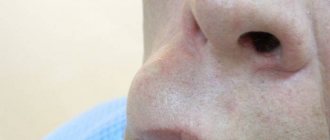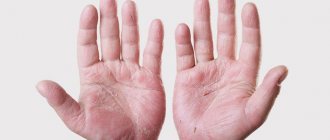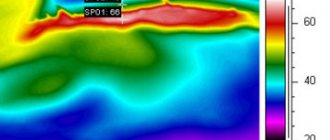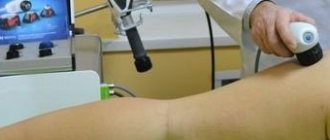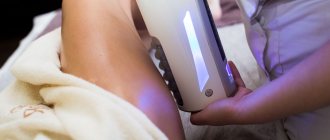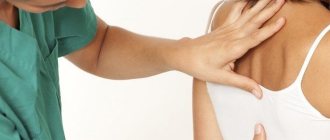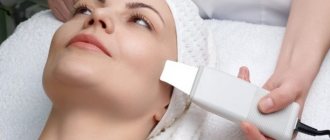Lipodystrophy, which is most often called lipoatrophy, refers to diseases from the group of metabolic disorders. It is characterized by abnormal growth of adipose tissue, which leads to its partial or complete loss. Disturbances in metabolic mechanisms as a result of this disease lead to liver steatosis, diabetes mellitus, etc. Complications that may arise as a result of this disease (kidney disease, acanthosis, etc.) significantly complicate the patient’s quality of life.
Lipodystrophy can be hereditary or acquired. Currently, lipodystrophy is most common among patients undergoing antiretoviral therapy prescribed for HIV infection.
Types of lipodystrophy
Congenital lipodystrophy
refers to a rare metabolic syndrome, which is characterized by a complete or partial absence of fatty tissue in the body. The disease is noticeable immediately at birth, since the baby does not have adipose tissue, except in the area of the scalp and soles of the feet.
Hereditary local lipodystrophy is a rare genetic disease that is transmitted as a dominant trait. It can occur in both women and men. At birth, this disease is not noticeable, but actively manifests itself in childhood and adolescence and is manifested by the accumulation of subcutaneous fat in the neck, face and limbs. Patients are characterized by the formation of a fatty hump between the shoulder blades.
Acquired lipodystrophy is an extremely rare form of the disease, most common in women. It appears in adolescence as a consequence of a viral infection. In almost all patients, the disease causes complications in the kidneys.
Acquired generalized lipodystrophy , a rare form in which there is loss of fat tissue throughout the body. As a rule, at birth the patient has a normal state of subcutaneous fat, but in childhood or adolescence there is a sharp loss of it. This disease can manifest itself after an infection: hepatitis, pneumonia, diphtheria, polio, chickenpox. As a rule, diabetes develops in parallel at the beginning of the disease.
Ring-shaped lipodystrophy is extremely rare and occurs mainly in women. Loss of adipose tissue occurs symmetrically, in the form of a ring, without inflammatory phenomena.
Localized lipodystrophy appears as a response to insulin administration, with loss of adipose tissue at the injection site.
HIV-associated lipodystrophy,
characteristic of patients who suffer from HIV infection.
Gynoid lipodystrophy
Gynoid lipodystrophy (sometimes mistakenly called cellulite) is a dystrophic condition of the skin and subcutaneous fat, manifested by a violation of the relief of the skin of the thighs, buttocks, abdomen and some other areas of the body.
According to medical statistics, more than 80% of women over 30 years of age and after childbirth have this disorder of varying severity. For this reason, aesthetic medicine procedures to correct this condition are very popular among patients. The World Health Organization does not consider gynoid lipodystrophy to be an independent nosological entity. According to the modern classification, this condition is one of the dystrophic manifestations that accompany the process of obesity or skin aging. The direct cause of pathological processes in lipodystrophy is a violation of microcirculation and lymphatic drainage in the hypodermis, causing the growth of coarse connective tissue in the intercellular septa of adipose tissue.
The disorder develops in stages, each stage can gradually flow into the next over several years. Correction of gynoid lipodystrophy becomes more complicated as this condition progresses; at each stage, the cosmetologist uses various injection techniques and medications for them:
- At the first stage, during the process of obesity, new adipocytes are formed in the hypodermis. This disrupts the nutrition of previously formed fat cells. All this leads to the development of tissue edema and retention of intercellular fluid in the tissues. All these changes characterize the so-called “soft cellulite”.
- At the second stage, edema leads to stimulation of fibroblasts in the stroma of adipose tissue. The proliferation of connective tissue fibers begins. These processes impede blood circulation and lymphatic drainage, leading to further development of edematous phenomena. The skin loses its firmness and elasticity.
- The third stage is characterized by further growth of connective tissue - not only coarse fibers, but also nodules can form. A sharp coarsening of collagen fibers leads to the development of the so-called “orange peel” - the appearance of a rough and uneven skin texture.
- The final stage of development of gynoid lipodystrophy can be characterized as a progressive increase in all of the above pathological processes. Symptoms such as skin soreness and the appearance of rough nodules may appear.
Gynoid lipodystrophy in the early stages of development responds well to many injection techniques of aesthetic medicine. In the future, the number of contraindications and side effects increases, which the cosmetologist must tell the patient about.
Symptoms of lipodystrophy
Since lipodystrophy is provoked by a variety of metabolic disorders, its symptoms can vary significantly. The main clinical manifestations of the disease are:
- General or partial loss of subcutaneous fat.
- Excessive deposition of fatty tissue in certain parts of the body, most often the face.
- Fat atrophy.
- In some cases, diabetes.
- Insulin resistance.
Diagnosis of lipodystrophy
Often, to establish a diagnosis, it is enough to evaluate the clinical picture of the disease. Laboratory tests may be ordered to determine blood glucose, triglyceride, and lipid levels. Differential diagnosis is necessary in relation to diseases such as HIV, cancer cachexia, Cushing's disease, anorexia nervosa, thyrotoxicosis, etc.
Causes of cellulite
Scientists and doctors are still arguing about the causes of cellulite. Among the many factors that are direct or indirect causes of poor circulation and fat metabolism and, consequently, cellulite, the following are most likely formulated.
- Hormonal imbalance, primarily ovarian dysfunction, thyroid disease and other hormonal pathologies.
- Impact of external factors - violation of proper diet, physical inactivity.
- Acute and chronic stressful situations.
- Hereditary and constitutional factors.
Whatever the leading cause, the root cause of cellulite at the tissue level is always a violation of microcirculation . Restoring locally impaired microcirculation is the main task in the treatment of cellulite. This means that adipose tissue will cease to be a “dead zone” and will actively participate in the metabolic process, and, therefore, it will become possible to reduce the fat content in cells. This task is very difficult, and success will depend on many conditions.
Treatment of lipodystrophy
In modern medicine, there are currently no effective methods for treating this disease. Therapy is aimed at adjusting the patient’s diet and physical exercise. Although the role of diet in this disease is not so significant, it is a preventive measure in the progression of the disease.
The diet for patients with lipodystrophy has the same principles as for heart disease and diabetes, since it is quite often accompanied by cardiovascular diseases.
In recent years, in developed countries, cosmetic (plastic) methods for correcting lipodystrophy have begun to be used through the use of temporary or permanent fillers (medical silicone, collagen).
Morphological features
An MRI examination of people of both sexes showed that in women with gynoid lipodystrophy the number of fibrous septa in the subcutaneous fat is higher than in women without cellulite and men. Also, with cellulite, a greater thickness of fibrous septa was noted.
Rice. 2. Morphology of normal skin ( Normal Skin ) and skin with signs of gynoid lipodystrophy ( Cellulite ). There is a noticeable partial pressing of subcutaneous fat into the dermis, as a result of which the thickness of the dermal layer decreases, and characteristic “waves” appear on the skin (Manhattan Dermatology Specialists)
Classification
There are[1]:
- Congenital lipodystrophies:
- Beradinelli-Seip syndrome;
- Familial partial lipodystrophy.
- Acquired lipodystrophies:
- Barraquer-Simons syndrome (acquired partial lipodystrophies);
- Acquired generalized lipodystrophies;
- (Lipodystrophia centrifugalis abdominalis infantilis);
- Lipoatrophia annularis (Ferreira-Marques lipoatrophy);
- Insulin lipodystrophies;
- HIV-associated lipodystrophies;
- Other localized lipodystrophies.
Treatment methods
Various methods can be used for therapy. To get rid of disorders of subcutaneous adipose tissue, the following methods are used:
- physiotherapy;
- massage;
- changing the site of insulin administration (at least temporarily).
READ ALSO: Gunpowder Sokol: characteristics, load, ammunition equipment
To facilitate the administration of insulin, you can additionally use novocaine. A specific treatment regimen should be drawn up by a doctor, taking into account the individual characteristics of the person.
Playing sports will help increase the effect of therapeutic effects. Light physical exercises that indirectly engage the abdominal muscles will help fight emerging dystrophy, and will also help eliminate old changes. The doctor may prescribe a complex of physical therapy. Proper nutrition also plays an important role both in the fight against the underlying disease and its complications.
Important! It may take several months for the dystrophic element to resolve. In some people with a predisposition to developing keloids, the lump or lipodystrophy may remain in some form permanently.
Prevention of lipodystrophy
Lipodystrophy is a disease that is difficult to cure completely, if not impossible. But you can prevent its development.
To prevent lipodystrophy from making itself felt, you need to follow some simple rules when administering insulin:
- Firstly, it is very important to change the injection site with each injection. You can create a schedule for changing injection sites by dividing insulin injection sites into small sections. The next injection of insulin should be 2-3 cm further from the previous one;
- Secondly, it is important to carry out the injection itself correctly - inject insulin subcutaneously, hold the needle at an angle, and, if necessary (in case of injecting insulin into the abdomen), make a small fold of skin;
- Thirdly, insulin should be at room temperature; do not administer insulin that has just been taken out of the refrigerator;
- Fourthly, change the needle on the syringe pen more often, do not allow the needle to become completely dull.
These simple rules will help you avoid very serious problems in the future.
Reasons for appearance
In diabetes, tissue lipodystrophy develops due to improper use of insulin. The following factors can act as a trigger:
- use of old or poorly purified insulin preparations;
- reuse of a disposable syringe pen needle for injection;
- insulin dose higher than 10.1 units per day;
- no change in locations where injections are given.
READ ALSO: Pimples on the labia: why do white spots, inflammation of the small and large gonads, red pimples in the vagina occur? |
If injections are constantly given in one place on the abdomen without changing the location, then the fatty and subcutaneous tissue begins to change quickly. Compaction or, on the contrary, lipodystrophy occurs. At first, the lump feels like a small bump.
The likelihood of lipodystrophy also affects the presence of other chronic diseases. To carry out prevention, it is necessary to eliminate all provoking factors, achieve remission in the treatment of indolent diseases and prevent an increase in sugar.
Obesity or cellulite?
Some people believe that cellulite can only appear in overweight people, but this problem actually has nothing to do with being overweight. If a person experiences an increase in body weight, then fat cells simply accumulate, and with cellulite, blood circulation in the subcutaneous tissue is disrupted, lymphatic drainage decreases, and skin tone weakens.
Cellulite always develops in the same way for everyone, but the process of fat accumulation proceeds differently. There are gynoid and android obesity, as well as its mixed type.
- Android obesity (or it is also called male-pattern obesity) is characterized by the accumulation of the bulk of deposits on the body. This type is quite dangerous because fat accumulates on the internal organs, which can impede their functioning.
- Gynoid obesity occurs most often in women. Deposits accumulate on the thighs, buttocks, and lower abdomen. This arrangement of fat cells is less dangerous; if the amount of excess kilograms does not reach a critical level, this will not interfere with the functioning of the internal organs.
- The mixed type is characterized by an almost uniform distribution of fat on the body.
In addition to the structure of adipose tissue, there are still quite large differences between cellulite and excess weight, which lie, first of all, in the reasons for their appearance.
How to prevent the condition from getting worse
Diabetes is an extremely dangerous disease if adequate measures are not taken to combat it. Any diabetic should adhere to the following rules while fighting their illness:
- elimination of all symptoms and complications of high sugar;
- regular glucose monitoring;
- fight against chronic pathologies in the body;
- relief and prevention of dystrophies that interfere with injections.
First of all, you need to eliminate all third-party diseases. In diabetes, any pathological lesion is more severe than in a healthy person. You should also adjust your diet by eliminating all fast carbohydrates, fatty and fried foods.
Lipodystrophy may appear several years after the start of replacement therapy. If all the rules of prevention have been followed, but the complication still makes itself felt, then you should try to use only long-acting insulin, maximizing the interval between injections. This will slightly improve the condition of fatty skin tissue.
READ ALSO: Black French nails: more than 51 photos of new products and trends for 2020
You should regularly consult a specialist, especially if you need to somehow adjust the plan for combating the disease. The use of modern drugs and syringe pens for insulin allows us to avoid complications.
Alternating injection areas
Insulin injections are given in the stomach. To minimize harm to the fat layer, it is necessary to regularly alternate the areas of drug administration. Conventionally, the stomach can be divided into 4 squares. It is recommended to make each new injection 1 cm from the old one. The injection can also be carried out in the upper thigh and buttocks.
With proper planning and weekly rotation from one square to another, the subcutaneous tissue will have the opportunity to recover after injections. Thus, a collision with lipodystrophy will not occur even with extremely long-term treatment.
To understand whether the area has recovered after the injection, you should carefully palpate it. If there are no compactions or visual changes, and more than 1 week has passed, then you can inject again in the same place.
Does excess weight affect lipodystrophy?
Too much body fat and excess weight negatively affect the general condition of the body. The likelihood of developing tissue hypertrophy also increases. It is recommended to try to follow a diet and set the dosage of the hormone so that the weight gradually decreases and is within the normal body mass index.
A diabetic diet should be balanced. The body must receive all the necessary micro- and macroelements. To prevent glucose from jumping too much, you need to exclude all sweets from your diet. Preference is given to complex carbohydrates, salads and steamed foods.
Important! The diet should be prepared in consultation with a qualified physician. Errors in nutrition lead to a deterioration in overall health and the progression of diseases along with its complications.
